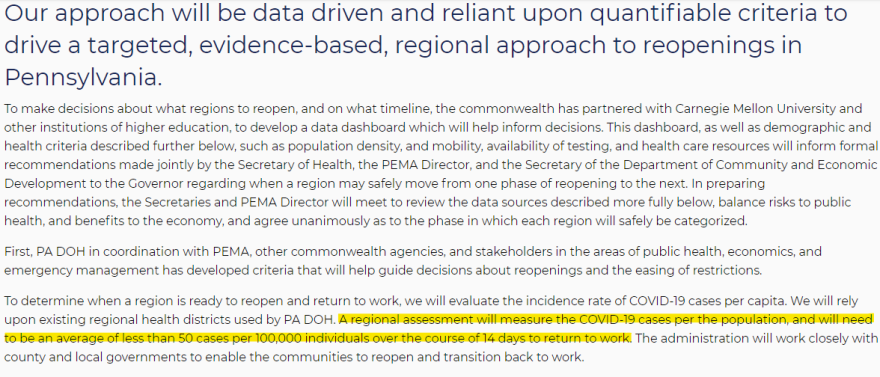On Wednesday evening, Governor Tom Wolf began rolling out details of his plan for reopening Pennsylvania. One of the plan's key points is a long-awaited metric for determining when a county would qualify for reopening.
“The initial benchmark we're setting is for the population to have an average of less than 50 cases per 100,000 individuals over the course of 14 days in order to return to work,” Wolf said in his address. The state would also look at factors like a local health system's capacity for handling for a possible spike in cases, he added.
Officials say the state will be looking at two-week averages as Pennsylvania gears up to begin a reopening process in some areas on May 8. But between Wednesday evening and Thursday morning, the administration made a revision on its “Process to Reopen Pennsylvania” website – a tiny adjustment in wording that, if correct, would mean a massive change to reopening policy.
On Wednesday evening, the website mirrored Wolf’s public statement: “A regional assessment will measure the COVID-19 cases per the population, and will need to be an average of less than 50 cases per 100,000 individuals over the course of 14 days to return to work.”
By Thursday morning, the passage was changed to “A county can make the list for consideration to open if they, on average for the past 14 days, had 50 or less new cases per 100,000 residents per day.”
At issue is whether the administration is applying its 50-case limit per day or over a two-week period.


Allegheny County has roughly 1.2 million residents. Under the initial version, the county would need to have 600 or fewer cases during a two-week period -- about 42 cases per day -- in order to be considered for a lifting of some restrictions. For the past two weeks, the county has averaged about 28 cases per day.
Under the second version of the state's policy, which as of Friday afternoon was still live on the website, the county would just need to have an average of 600 or fewer cases every day during the two-week period to qualify. The county, which has reported only 1,177 total cases since March, has never come close to that. Its highest daily total was 76 on April 4.
And if the limits were to apply to daily totals, even the counties hardest hit by the pandemic would qualify for an easing of restrictions.
Philadelphia County has 1.5 million residents, so 50 cases per 100,000 people would amount to 750 cases. For the two-week period beginning April 9th – the most recent for which data is available on the city’s website – Philadelphia saw 5,485 new cases, or an average of about 392 cases per day. If the state applied its 50-case standard over two weeks, Philadelphia still has a ways to go before limits can be eased. But if Philadelphia is permitted to have 750 cases per day, it would qualify for consideration to reopen.
When asked about the discrepancy during a media briefing on Friday afternoon, state Health Secretary Dr. Rachel Levine said that the state was looking at case totals compiled over two weeks, not every day. But she appeared unaware that the incorrect information remained on the state’s website.
“We did revise that on our website, and it was really just a clarification. So I would go to pa.gov and you can see the exact criteria that we’ll be using,” Levine said.
Reporters are unable to ask follow-up questions during the daily media briefings, as questions are submitted in advance and read – not always verbatim – by a Department of Health spokesperson. The spokesperson did not ask the part of WESA’s question about why the website was changed to include erroneous information, when the first version of the website was seemingly correct.
The Allegheny County Health Department has not yet commented on what guidance it has received from the state.




